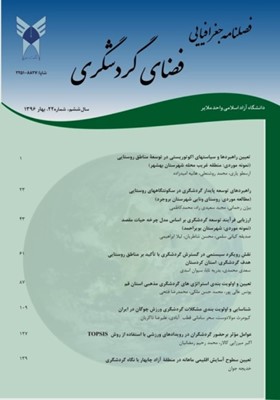راهبردهای توسعه پایدار گردشگری در سکونتگاههای روستایی (مطالعه موردی: روستای ونایی شهرستان بروجرد)
محورهای موضوعی : مربوط به گردشگری
کلید واژه: گردشگری, توسعه پایدار, مدل AHP, روستای ونایی, مدل برنامهریزی راهبردی,
چکیده مقاله :
گردشگری امروزه در چارچوب طرحهای آمایشی اعم از ملی، منطقهای و محلی بهعنوان یکی از ابزارها و مؤلفههای اثرگذار توسعه و محرومیتزدایی به شما میرود و ازمهمترین عوامل عمران ناحیهای است. فعالیتی متعادلکننده که موجب توسعه اقتصادی و اجتماعی در سطح منطقهای شده و توزیع عادلانه درآمد و همچنین سطح اشتغال را به دنبال دارد. بنابراین گردشگری روستایی نیز جزئی از صنعت گردشگری بهحساب میآید که میتوان با برنامهریزی اصولی و مناسب و شناسایی مزیتها و محدودیتهای آن، نقش مؤثری در توسعه محلی و درنتیجه توسعه ملی و تنوعبخشی به اقتصاد ملی بر عهده داشته باشد، ازاینرو در این پژوهش سؤال این است که پتانسیلها و محدودیتهای توسعه پایدار گردشگری در روستای ونایی کدام است؟ و چه راهبردها و راهکارهایی جهت توسعه پایدار گردشگری که منجر به توسعه روستایی و توسعه منطقهای و ملی بشود وجود دارد؟ به این منظور پژوهش حاضر با استفاده از مطالعات میدانی و تعیین نقاط قوت، ضعف، فرصتها و تهدیدها به شیوه مدل برنامهریزی راهبردی SWOT و ترکیب آن با AHP به ارائه و اولویتبندی استراتژیها و راهبردها در جهت توسعه پایدار گردشگری در روستای ونایی پرداخته است. تجزیهوتحلیلهای تجربی در روستای مورد مطالعه نشان میدهد که آستانه آسیبپذیری این روستا به علت گردشگری بودن بالاست و نیازمند ارائه سیاستهای مناسب در جهت رفع محدودیتها و استفاده از مزیتهای نسبی موجود میباشد.
Tourism in the context of spatial planning projects, whether the projects are national, regional or local, is one of the most effective components of development and deprivation. It is also one of the most important factors of regional development. Tourism is a balancing activity which causes economic and social development at the regional level as well as the equal distribution patterns of income and employment. Therefore, rural tourism is also a part of tourism industry which is considered to be the proper planning and delineating its advantages and limitations which in its own turn has an effective role in local and national development and diversification of the national economy. Thus, the questions of the present study were that what the potential and limitations of sustainable tourism development in the village of Vanai were; what strategies for sustainable tourism development would contribute to rural, regional and national development.The researchers of the present study used a field study to determine the strengths, weaknesses, opportunities and threats as a SWOT model for strategic planning and combined it with AHP to prioritize the strategies for sustainable tourism development in Vanai village. Experimental analysis in the area under study showed that due to the extreme vulnerability of the village, effective strategies are needed to eliminate the existing restrictions and thus to make use of its relative advantages.
_||_

